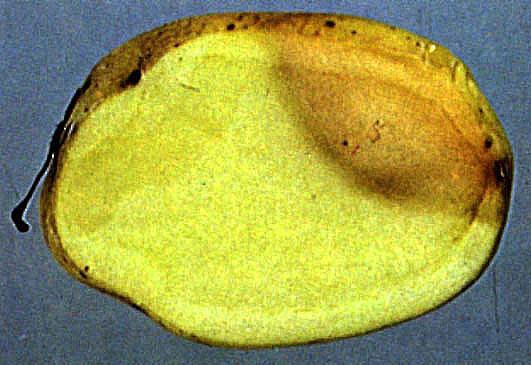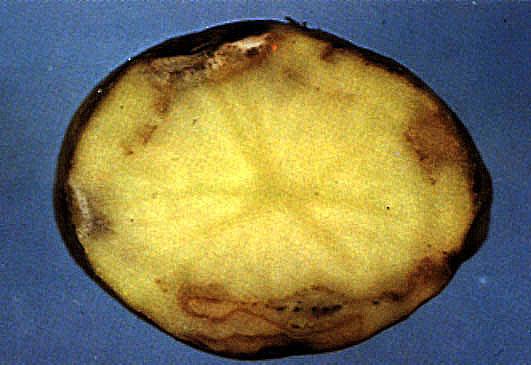Potatisens fryspunkt ligger vid -1 till -2°C. Tillfällig underkylning av potatis ned till -5°C kan förekomma utan att isbildning sker i knölarna. En absolut förutsättning härför är dock fullständig vila.
Utsättes knölarna för ristning eller stötar, inträder ögonblickligen isbildning. Potatis som under längre tid lagrats mellan 0º och 4ºC blir ”härdade” och tål bättre än ”ohärdad” potatis en tillfällig nedkylning under 0ºC. Frostskador kan variera mycket i utseende och betydelse allt efter frostens styrka och långvarighet, men även beroende på den hastighet med vilken nedkylning respektive upptining sker.
Enligt SMAK´s bedömningssystem indelas frostskadorna i två huvudgrupper; blöta och torra frostskador.

Stelfrusna knölar. Frostskadade delar av knölar blir vid upptining helt mjuka och vattniga. En kort stund efter uppskärning färgas snittytorna rosa för att senare svartfärgas. Skadan övergår snabbt i blötröta.
Gummimjuka knölar. Skadan avslöjas till det yttre endast genom att knölarna får en gummiliknande konsistens. Snitt färgas rödbruna och runt lenticellerna bildas, efter 4-5 dagar, mörka fläckar. Knölarna är mycket mottagliga för bakterierötor.

Frost damage
Potatoes freeze at -1 to -2º C. Temporary chilling down to -5º C can occur without ice forming in the tubers, an absolute condition, however, being that they are absolutely still. Ice forms immediately if the tubers are shaken or jarred.
Potatoes, which are stored between 0º and 4º C for long periods, become ”hardened” and can withstand a brief drop in temperature below 0º C better than ”unhardened” potatoes. Frost damage can vary considerably in appearance and significance depending on the degree and duration of the frost, and also on the rate at which the freezing and thawing take place.
The SMAK grading system divides frost damages into the following two categories:
Wet frost
- Hard frozen tubers. The frozen parts of the tubers turn completely soft and waterly on thawing. Cut surfaces quickly turn pink and later black. The damage rapidly becomes bacterial soft rot.
- Spongy tubers. The damage can only be detected externally by rubber-like consistency of the tuber. Cut surfaces turn reddish-brown and dark spots form round the skin pores after 4-5 days. The tubers are extremely susceptible to bacterial rot.
Fry frost
- Surface necrosis. The damage can occur when a tuber is pressed against a frozen object. A similar injury is displayed by certain tubers, which have been subjected to night frost during late growth while still in the ground. The damages surfaces – or patches – are usually somewhat depressed and grey-brown in colour. The damage can be entirely superficial, although it can also spread into the tuber, were it usually has a well-defined demarcation with healthy tissue. The damaged cells in the tuber are grey-brown in colour.
- Ring necrosis. The necrosis usually appears as dark discoloration in and around the vascular ring. The injury can arise after only a few hours chilling (although not below -5º C when the tubers freeze hard). Minor necrosis occurring in patches is easily confused with blue spots.
- Other symptoms, such as marbling and web necrosis, are less common. In cases of premature sprouting, the eyes can be damaged by frost without any visible effect on the tubers, although fertility is reduced very considerably.